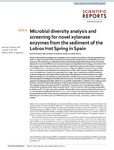Mostrar o rexistro simple do ítem
Microbial diversity analysis and screening for novel xylanase enzymes from the sediment of the Lobios Hot Spring in Spain
| dc.contributor.author | Knapik, Kamila | |
| dc.contributor.author | Becerra, Manuel | |
| dc.contributor.author | González-Siso, María-Isabel | |
| dc.date.accessioned | 2019-09-16T10:44:23Z | |
| dc.date.available | 2019-09-16T10:44:23Z | |
| dc.date.issued | 2019-08-01 | |
| dc.identifier.citation | Knapik, K., Becerra, M. & González-Siso, M. I. Microbial diversity analysis and screening for novel xylanase enzymes from the sediment of the Lobios Hot Spring in Spain. Sci Rep 9, 11195, https://doi.org/10.1038/s41598-019-47637-z (2019). | es_ES |
| dc.identifier.issn | 2045-2322 | |
| dc.identifier.uri | http://hdl.handle.net/2183/23942 | |
| dc.description.abstract | [Abstract] Here, we describe the metagenome composition of a microbial community in a hot spring sediment as well as a sequence-based and function-based screening of the metagenome for identification of novel xylanases. The sediment was collected from the Lobios Hot Spring located in the province of Ourense (Spain). Environmental DNA was extracted and sequenced using Illumina technology, and a total of 3.6 Gbp of clean paired reads was produced. A taxonomic classification that was obtained by comparison to the NCBI protein nr database revealed a dominance of Bacteria (93%), followed by Archaea (6%). The most abundant bacterial phylum was Acidobacteria (25%), while Thaumarchaeota (5%) was the main archaeal phylum. Reads were assembled into contigs. Open reading frames (ORFs) predicted on these contigs were searched by BLAST against the CAZy database to retrieve xylanase encoding ORFs. A metagenomic fosmid library of approximately 150,000 clones was constructed to identify functional genes encoding thermostable xylanase enzymes. Function-based screening revealed a novel xylanase-encoding gene (XynA3), which was successfully expressed in E. coli BL21. The resulting protein (41 kDa), a member of glycoside hydrolase family 11 was purified and biochemically characterized. The highest activity was measured at 80 °C and pH 6.5. The protein was extremely thermostable and showed 94% remaining activity after incubation at 60 °C for 24 h and over 70% remaining activity after incubation at 70 °C for 24 h. Xylanolytic activity of the XynA3 enzyme was stimulated in the presence of β-mercaptoethanol, dithiothreitol and Fe3+ ions. HPLC analysis showed that XynA3 hydrolyzes xylan forming xylobiose with lower proportion of xylotriose and xylose. Specific activity of the enzyme was 9080 U/mg for oat arabinoxylan and 5080 U/mg for beechwood xylan, respectively, without cellulase activity. | es_ES |
| dc.language.iso | eng | es_ES |
| dc.publisher | Springer Nature | es_ES |
| dc.relation | info:eu-repo/grantAgreement/EC/FP7/324439 | es_ES |
| dc.relation.uri | https://doi.org/10.1038/s41598-019-47637-z | es_ES |
| dc.rights | Atribución 3.0 España | es_ES |
| dc.rights.uri | http://creativecommons.org/licenses/by/3.0/es/ | * |
| dc.subject | Metagenomics | es_ES |
| dc.subject | Biodiversity | es_ES |
| dc.subject | Functional screening | es_ES |
| dc.subject | Xylanase | es_ES |
| dc.subject | Hot spring sediment | es_ES |
| dc.title | Microbial diversity analysis and screening for novel xylanase enzymes from the sediment of the Lobios Hot Spring in Spain | es_ES |
| dc.type | info:eu-repo/semantics/article | es_ES |
| dc.rights.access | info:eu-repo/semantics/openAccess | es_ES |
| UDC.journalTitle | Scientific Reports | es_ES |
| UDC.volume | 9 | es_ES |
| UDC.startPage | 11195 | es_ES |
Ficheiros no ítem
Este ítem aparece na(s) seguinte(s) colección(s)
-
GI-EXPRELA - Artigos [28]
-
OpenAIRE [358]






